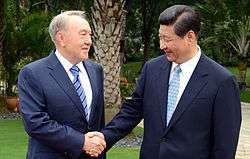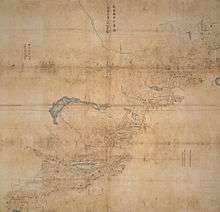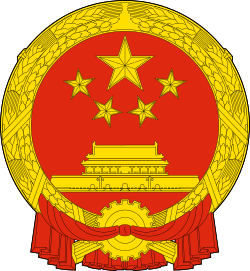China–Kazakhstan relations
 |
|
Kazakhstan |
China |
|---|---|

The bilateral relations between the Republic of Kazakhstan and the People's Republic of China have assumed an important strategic role with expanding commercial and strategic cooperation between the two nations.
History
Han Dynasty to Qing Dynasty
Historians say that China came in contact with the Kazakhstan region since as early as the 2nd century BC. The Kazakhstan region was very useful between China and the West.
During the Han Dynastry, one of Kazakhstan's ancestors, the Wusun, intermarried with China, marking the beginning of relations. During the rule of Emperor Wu of Han, Zhang Qian was an official dispatched to the Western Regions to help the Wusun against the Xiongnu. Since the Wusun did not want to cooperate with the Xiongnu, they allied with the Han dynasty to push the Xiongnu out.
Modern times
Before the fall of the Soviet Union, the People's Republic of China and Kazakhstan (while in the Soviet Union) were previously communist states.
The People's Republic of China and Kazakhstan formed diplomatic relations on January 3, 1992. The two nations signed their first boundary agreement in April 1994, a supplementary agreement in September, 1997, and their second supplementary boundary agreement in July 1998 to mark their 1,700 kilometres (1,100 mi) shared border.[1] In 1993, the President of Kazakhstan Nursultan Nazarbayev made an official visit to Beijing at the invitation of the then-Chinese President Jiang Zemin. Since then, the leaders of China and Kazakhstan have frequently exchanged high-level official visits. In 1996, both nations became co-founders of the Shanghai Cooperation Organisation.[1]
Development of bilateral relations


China and Kazakhstan have promoted a rapid expansion of commerce and partnership over economic development, especially in harnessing Kazakhstan's oil, natural gas, minerals and other major energy resources.[5][6] Owing to rapidly expanding domestic energy needs, China has sought to obtain a leading role in cultivating and developing energy industries in Kazakhstan.[6] Along with operating four smaller oil fields, the China National Petroleum Corporation in 2005 bought Petrokazakhstan, that was the former Soviet Union's largest independent oil company, for US$4.18 billion and spent another USD 700 million on a pipeline that will take the oil to the Chinese border. Petrokazakhstan was the largest foreign purchase ever by a Chinese company.[5]
In 2009 China lent $10 billion to Kazakhstan and gained a stake in MangistauMunaiGas.[7]
On October 16, 2013, the Kazakhstan Majilis and China's Standing Committee of the National People's Congress (NPCSC) signed a memorandum of understanding. The agreement is the most important legislations signed between the two nations that further bilateral relations. The legislation helps both parliaments meet together to discuss bilateral issues amongst one another.[8]
Strategic cooperation
Aimed at bolstering regional partnership on regional security, economic development and fighting terrorism and drug trafficking amongst Central Asian nations, Kazakhstan and China become co-founders of the Shanghai Cooperation Organisation (SCO).[1] In developing ties with China, Kazakhstan aims to balance the geopolitical and economic influence of its northern neighbour Russia.[5][6] However, potential conflicts exist around China's cultural ties between the Kazakh people and the Uighurs of China's Xinjiang province, which could influence a Uighur separatist movement.[6] China also aims to prevent the growth of U.S. influence in the region and the possible establishment of American air bases in Kazakhstan.[5][6] In 1997, both nations signed an agreement to reduce the presence of military forces along the common border along with Kyrgyzstan, Tajikistan.[1]
Border agreements

The origins of the border line between China and Kazakhstan date from the mid-19th century, when the Russian empire was able to establish its control over the Lake Zaysan region. The establishment of the border between the Russian Empire and the Qing Empire, not too different from today's Sino-Kazakh border was provided for in the Convention of Peking of 1860;[9] the actual border line pursuant to the convention was drawn by the Protocol of Chuguchak (1864), leaving Lake Zaysan on the Russian side.[10][11] The Qing Empire's military presence in the Irtysh basin crumbled during the Dungan revolt (1862–77). After the fall of the rebellion and the reconquest of Xinjiang by Zuo Zongtang, the border between the Russian and the Qing empires in the Irtysh basin was further slightly readjusted, in Russia's favor, by the Treaty of Saint Petersburg (1881).
After the Xinhai Revolution and the Chinese Civil War, the October Revolution and the Russian Civil War in Russia, the Sino-Russian border became the PRC-USSR border. However, the Chinese and Soviet authorities were not always in agreement where the border line run on the ground, which led, in particular to a border conflict east of lake Zhalanashkol in August 1969.
After Kazakhstan became an independent country, it negotiated a border treaty with China, which was signed in Almaty on April 26, 1994, and ratified by the Kazakh president on June 15, 1995. According to the treaty, a narrow strip of hills east of Zhalanashkol which the USSR and China had contested in 1969 have become recognized as part of China.[12]
To delineate certain small sections of the border more precisely, additional agreements were signed on 24 September 1997 and 4 July 1998.[13] Over the next several years, the border was demarcated on the ground by joint commissions. According to the commissions protocols and maps, the two countries' border line is 1782.75 km long, including 1215.86 km of land border and 566.89 km of border line run along (or across) rivers or lakes. The commissions' work was documented by several joint protocols, finalized with the Protocol signed in Beijing on May 10, 2002.[13]
Cross-border water management
The two most important rivers of eastern Kazakhstan - the Irtysh and the Ili - flow from China. Their waters are extensively used for irrigation and urban water supply in both countries (in particular, via China's Irtysh–Karamay–Ürümqi Canal and Kazakhstan's Irtysh–Karaganda Canal). Besides, the Ili is the main source of water for Kazakhstan's Lake Balkhash, and the smaller Emil River, also flowing from China, supplies water to Kazakhstan's Lake Alakol. Accordingly, since the 1990s, the increasing use of the two transboundary rivers' water in China has been of concern for Kazakhstan's environmentalists and politicians.[14] [15] Bilateral negotiations are periodically conducted on the related issues.[15][16]
Bibliography
- Cardenal, Juan Pablo; Araújo, Heriberto (2011). La silenciosa conquista china (in Spanish). Barcelona: Crítica. pp. 59–70.
References
- 1 2 3 4 "Brief introduction to relations between China and Kazakhstan". China Daily. 2003-05-27. Retrieved 2008-10-10.
- ↑ Millward, James A. (2007), Eurasian crossroads: a history of Xinjiang, Columbia University Press, pp. 45–47, ISBN 0231139241
- ↑ 前10个月新疆阿拉山口口岸铁路货运增长12.8% (Freight volume at Xinjiang's Alashankou port of entry is up by 12.8% for the first 10 months of the year), 2012-11-23, 中商情报网
- ↑ 新疆霍尔果斯火车站获批成立 年底有望通车, 中国新闻网, 2012-11-23
- 1 2 3 4 Pala, Christopher (2006-03-17). "China Pays Dearly For Kazakhstan Oil". New York Times. Retrieved 2008-10-10.
- 1 2 3 4 5 Marat Yermukhanov (2004-07-09). "China's relations with Kazakhstan are warming, but to what end?". Association for Asian Research, Jamestown Foundation. Retrieved 2008-10-10.
- ↑ China's Hu Kicks Off Central Asian Energy Tour
- ↑ http://en.tengrinews.kz/politics_sub/Kazakhstans-Majilis-and-Chinas-NPCSC-sign-a-Memorandum-on-understanding-23331/
- ↑ Articles 2 and 3 in the Russian text of the treaty
- ↑ (See the map)
- ↑ The Lost Frontier: the treaty maps that changed Qing's northwestern boundaries
- ↑ See the text of the "Agreement between the Republic of Kazakhstan and the People's Republic of China on the Kazakhstan-China international border, signed in Almaty on Aprel 26, 1994" in О ратификации Соглашения между Республикой Казахстан и Китайской Народной Республикой о казахстанско-китайской государственной границе. Указ Президента Республики Казахстан от 15 июня 1995 г. N 2331. The border shown on Google Maps follows the description in the treaty; specifically, border point 38 described in the text is at the border line's crossing with the Terekty River (铁列克提河, Tielieketi he) can be seen at 45°37′00″N 82°15′30″E / 45.61667°N 82.25833°E. The 1969-era Soviet claim in the area can be seen on the period's topo maps, e.g. border point No. 40 on this map.
- 1 2 О ратификации Протокола между Правительством Республики Казахстан и Правительством Китайской Народной Республики о демаркации линии казахстанско-китайской государственной границы. Закон Республики Казахстан от 4 июля 2003 года, N 469. ("On the ratification of the Protocol agreed by the Government of the Republic of Kazakhstan and the Government of the People's Republic of China on the demarcation of the line of the Kazakhstan-China international border. Law No. 469 of the Republic of Kazakhstan. July 4, 2003")
- ↑ Stone, Richard (2012-07-27), "For China and Kazakhstan, No Meeting of the Minds on Water" (PDF), Science, 337: 405–407
- 1 2 Sievers, Eric W. (2002), "Transboundary Jurisdiction and Watercourse Law: China, Kazakhstan and the Irtysh" (PDF), Texas International Law Journal, 37 (1)
- ↑ Казахстан и Китай решили совместо использовать трансграничные реки. Пока Иртыш не высох... (Kazakhstan and China have decided to jointly use transborder rivers. Until the Irtysh has not dried out...). 2003-02-25 (Russian)
- Jin Noda (6 April 2016). The Kazakh Khanates between the Russian and Qing Empires: Central Eurasian International Relations during the Eighteenth and Nineteenth Centuries. BRILL. ISBN 978-90-04-31447-4.
- NODA, Jin; ONUMA, Takahiro (2010). "A Collection of Documents from the Kazakh Sultans to the Qing Dynasty". Crosroads. TIAS Central Eurasian Research Series. Department of Islamic Area Studies, Center for Evolving Humanities, Graduate School of Humanities and Sociology, The University of Tokyo (Special Issue 1): i–176. ISBN 978-4-904039-17-5.
- Nurlan, KENZHEAKHMET (October 2013). "The Qazaq Khanate as Documented in Ming Dynasty Sources". Crosroads (8): 131–156.

